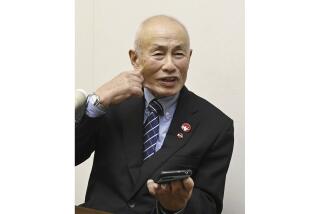Europe’s Peace Advocates Seek New Role
- Share via
BRUSSELS, Belgium — Not too long ago thousands marched against nuclear missiles in Europe and were dismissed by most Western governments as idealistic dreamers.
What are they doing now that their dreams are turning into reality and the Cold War is fading into history?
The peace movement, like the military and pro-nuclear establishment it fought for years, is seeking a new role.
“We are in a period where the symbols of war are falling all around,” said Sylvie Mantrant, international coordinator for the European Nuclear Disarmament Convention.
“The Western peace movements know we must reassess our goals and methods of campaigning,” said Meg Beresford, secretary general of Britain’s Campaign for Nuclear Disarmament. “People are no longer so afraid of nuclear war. It is harder for us to get our message across.”
Both women were present at a meeting of peace campaigners in Brussels in November that found fresh hope in the political reforms sweeping Eastern Europe.
“We are going to be able to work with people in countries like East Germany, Poland or Czechoslovakia quite openly now,” Beresford said. “Before, we had to keep those contacts pretty secret.”
The tide of “people power” behind what was once the Iron Curtain carries with it many who would like to see all nuclear weapons scrapped and huge cuts in military spending.
“Some of those people, in the reform movements, may well end up in government,” said Jane Mayes, a British representative for European Nuclear Disarmament. “That gives us fantastic opportunities for cooperation,” she said.
The heady days of the early 1980s, when thousands marched across Western Europe to protest the deployment of cruise and medium-range missiles by NATO, have gone.
A 1987 superpower treaty provided for the scrapping of those missiles and deprived the peace movement of obvious protest targets, such as the Greenham Common air base in southern England where cruise missiles were stored.
Now East and West are talking in Vienna about major reductions in conventional weapons and there is the prospect of treaties this year that could halve the superpowers’ strategic nuclear arsenals and cut chemical weapons stocks.
But those who campaign for an end to nuclear weaponry emphatically reject suggestions that history has passed them by, or that the 16-nation NATO alliance has been proved right in its strategy of maintaining military strength.
“The arguments of the military have no validity. NATO and the ‘hawks’ are making no real changes,” said Beresford.
“We would all like to go home and just look after our gardens, but the military programs are continuing. . . . Had it not been for the peace movement’s activities in the early 1980s, none of these changes would have been achieved.”
But the peace movement is less clear on the details of how it can help reshape the map of Europe.
The Brussels meeting, just down the road from NATO headquarters, was called to organize a unique international peace conference to be held next summer.
The venue will be a large ferry that will travel between Helsinki in neutral Finland and Tallin in the Soviet Union--a symbolic bridging of East and West.
“We are still working out the details of how the movement can take a broader approach and the convention next summer will deal with that,” said Beresford.
Some want to bring current environmental questions into the peace movement as a way of revitalizing it.
Other campaigners want to work towards creating a federal, neutral, nuclear-free Europe that would include other countries beyond the 12-member European Community.
“In changing times we have an enormous contribution to make to helping build East-West relations,” said Mantrant.
“We must learn to be loyal--neither to East nor West nor to particular countries, but to ourselves. We must try to give all citizens the choice about how the relationship between European peoples should develop.”
More to Read
Sign up for Essential California
The most important California stories and recommendations in your inbox every morning.
You may occasionally receive promotional content from the Los Angeles Times.













